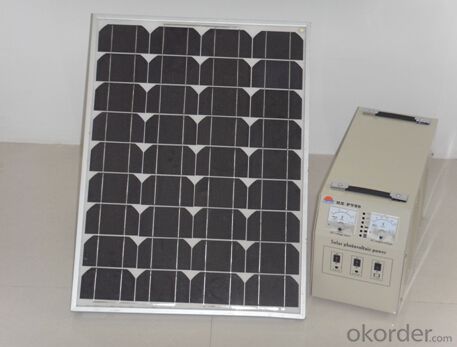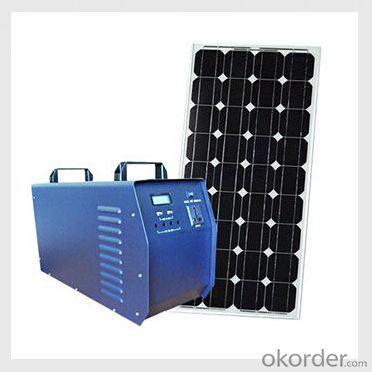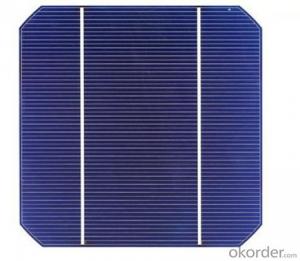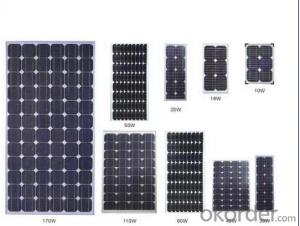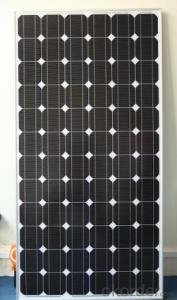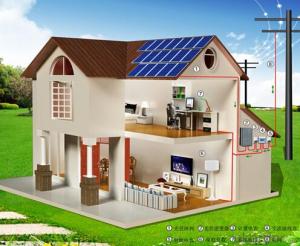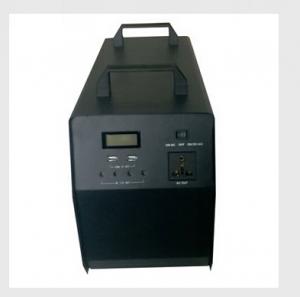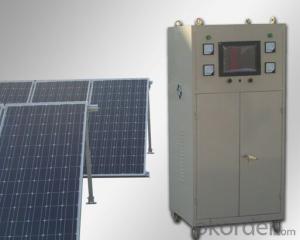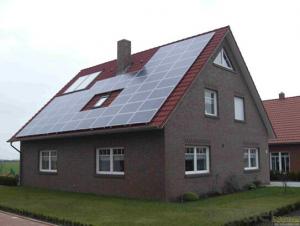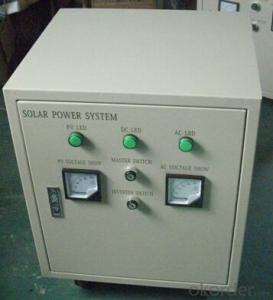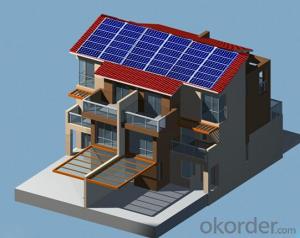CNBM Solar Roof Solar System 8000W with Solar Cells and Panels Popular in Africa
- Loading Port:
- Shanghai
- Payment Terms:
- TT OR LC
- Min Order Qty:
- 1 PCS
- Supply Capability:
- 30000 PCS/month
OKorder Service Pledge
OKorder Financial Service
You Might Also Like
Introduction of Solar Home System
Silicon remains the most popular material for solar cells, including these types:
Monocrystalline or single crystal silicon
Multicrystalline silicon
Polycrystalline silicon
Amorphous silicon.
The absorption coefficient of a material indicates how far light with a specific wavelength (or energy) can penetrate the material before being absorbed. A small absorption coefficient means that light is not readily absorbed by the material. Again, the absorption coefficient of a solar cell depends on two factors: the material making up the cell, and the wavelength or energy of the light being absorbed.
The band gap of a semiconductor material is an amount of energy. Specifically, the band gap is the minimum energy needed to move an electron from its bound state within an atom to a free state. This free state is where the electron can be involved in conduction. The lower energy level of a semiconductor is called the "valence band." The higher energy level where an electron is free to roam is called the "conduction band." The band gap (often symbolized by Eg) is the energy difference between the conduction band and valence band.
Solar cell material has an abrupt edge in its absorption coefficient; because light with energy below the material's bandgap cannot free an electron, it isn't absorbed.
Working Principle of Solar Roof System
The stand alone Solar Home System is an off-grid solar system which uses batteries to store the solar energy. Stand alone solar system solutions design for those who are not able or willing to connect to electricity grid.
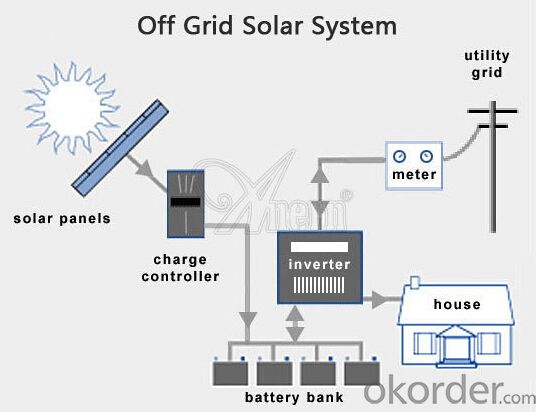
Specification of Solar Home System
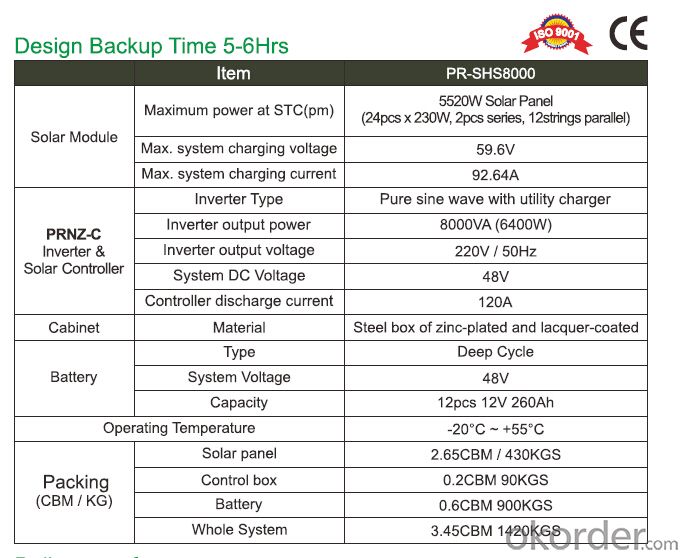
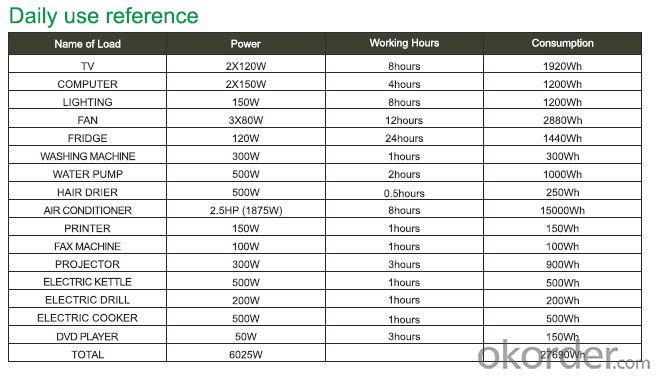
Product Features of Solar Home System
1. Off grid solar power system is mainly used for application with relatively-small power consumption, and the areas have no grid network coverage, or grid power is unstable or outage condition.
2. It’s composed of solar panels, hybrid solar inverter, battery bank, solar panel mounting racks, and other accessories required fora complete home solar power system.
3. The battery bank gives a stable power output to the solar inverter which converts DC to AC to power loads, and provides power backup in rainy or cloudy days.
4. The solar panels generate electricity at daytime and charge the battery bank.
5. The off grid home solar power system provides grid power bypass in case of battery power shortage when sunshine is not enough.
6. All the off grid home solar power system configurations are worked out by scientific calculation and design.

Advantage of Our Solar Home System
1 Excellent Performance: Our Solar Home System is composed by Brand Standard Kits with high quality. Our solar system has the advantage of high efficiency and stable operation. We can ensure our product with a long life period.
2. Small Orders Accepted: We can accept small orders as our customer’s trial order.
3. Warehouse: We have warehouse overseas which can bring great convenience to our customer to pick up the products.
Terms and Conditions
1. Trade terms: FOB Shanghai
2. Payment terms: 30% T/T, balanced before shipment/ LC at sight before shipment. Actual Terms can be negotiated for big order.
3. Package: Exported standard package suitable for tough handling and sea transport.
4. Delivery: Goods to be ready within 10~30 days depending on order quantity.
5. Warranty: 10 years for solar panel, 2 years for controller/inverter/battery.
FAQ
Q: Could you introduce the background of your company?
A: We are a Group corp. with 1GW capacity in China, which is Okorder’s registered VIP Supplier, possess Financial Service from Okorder.com.
Q: Required mainly certificates (CE&IEC/TUV/RoHS)?
A: Our products are certificated by CE RoHS, IEC, ISO, TUV, UL etc.
Q: Your main exported market is?
A: Main markets of our products is: South-east Asia, Mid-east, Arica, East Europe and Latin America.
- Q: Have you ever been to a solar cell power generation station?
- Of course, I've been there at least 3 times.
- Q: Are solar cells affected by pollution?
- Yes, solar cells can be affected by pollution. Airborne pollutants, such as dust, smog, or industrial emissions, can accumulate on the surface of solar panels, reducing their efficiency by blocking sunlight and decreasing their output. Regular cleaning and maintenance are essential to ensure optimal performance of solar cells in polluted environments.
- Q: How do solar cells perform in high altitude environments?
- Solar cells perform better in high altitude environments due to several factors. Firstly, at higher altitudes, there is less atmospheric pollution and haze, resulting in increased solar irradiance. This means that solar cells receive more sunlight, leading to higher energy production. Secondly, the lower air density at high altitudes reduces the heat dissipation from solar cells, allowing them to operate at lower temperatures. This improves their efficiency as solar cells tend to perform more efficiently in cooler temperatures. Additionally, the cooler climate at high altitudes also helps to prevent overheating, which can degrade the performance and lifespan of solar cells. Overall, solar cells tend to exhibit superior performance and efficiency in high altitude environments.
- Q: Are solar cells affected by extreme temperatures?
- Yes, solar cells can be affected by extreme temperatures. High temperatures can cause the efficiency of solar cells to decrease, as excessive heat can cause an increase in resistance and reduce the voltage output. Similarly, extremely cold temperatures can also impact their performance, although to a lesser extent. It is important to note that modern solar cells are designed to withstand a wide range of temperatures, and their efficiency is typically optimized within a specific temperature range.
- Q: Can solar cells be used in public infrastructure projects?
- Yes, solar cells can be used in public infrastructure projects. Solar cells, also known as solar panels, are an efficient and sustainable source of renewable energy. They can be integrated into various public infrastructure projects such as streetlights, bus stations, parking lots, and rooftops of public buildings, among others. By harnessing the power of the sun, solar cells can help reduce dependency on traditional energy sources, lower carbon emissions, and contribute to a more environmentally friendly and resilient public infrastructure.
- Q: What is the impact of solar cells on reducing energy poverty?
- Solar cells have a significant impact on reducing energy poverty by providing access to electricity in remote areas that are not connected to the grid. They offer a reliable and sustainable source of power, enabling households to meet their basic energy needs and improve their quality of life. Additionally, solar cells reduce dependence on expensive and polluting fossil fuels, making energy more affordable and environmentally friendly for those living in poverty.
- Q: We are currently promoting our one of our solar cells seriers, which is the 156mmx156mm 6inch,2BB/3BB polycrystalline/multi solar cells,mono solar cell,made in Taiwan/Germany, please feel free to contact me if any interest.
- I am now in the process of purchasing some mono solar cells, can you send me more details of the product?
- Q: How are solar cells made?
- Solar cells are typically made using a process called photovoltaic (PV) technology, which involves the assembly of semiconductor materials, usually silicon, into thin layers. The silicon is purified and then shaped into wafers, which are then treated with various dopants to create the desired electrical properties. Metal contacts are added to these wafers, and the cells are encapsulated with protective materials. When sunlight hits the cell, the photons from the sunlight create an electric field across the layers, generating electricity.
- Q: How do solar cells compare to other renewable energy sources?
- Solar cells have several advantages over other renewable energy sources. They are highly versatile and can be installed in various locations, from rooftops to large-scale solar farms. Solar energy is abundant and accessible in most parts of the world, making it a reliable and widely available source of power. Additionally, solar cells have a low environmental impact, as they produce electricity without emitting greenhouse gases or other pollutants. Finally, solar energy is becoming increasingly cost-effective, with declining prices for solar panels and improved efficiency. However, solar cells do have limitations, such as dependence on sunlight availability and the need for large areas of land for large-scale installations. Nonetheless, their numerous advantages make solar cells a valuable and promising renewable energy option.
- Q: Can solar cells be used in agricultural applications?
- Yes, solar cells can be used in agricultural applications. They can be used to power irrigation systems, provide electricity for farm equipment, and even to charge batteries for remote monitoring and control systems. Additionally, solar panels can be installed on agricultural buildings to generate renewable energy and reduce reliance on the grid.
Send your message to us
CNBM Solar Roof Solar System 8000W with Solar Cells and Panels Popular in Africa
- Loading Port:
- Shanghai
- Payment Terms:
- TT OR LC
- Min Order Qty:
- 1 PCS
- Supply Capability:
- 30000 PCS/month
OKorder Service Pledge
OKorder Financial Service
Similar products
Hot products
Hot Searches
Related keywords




